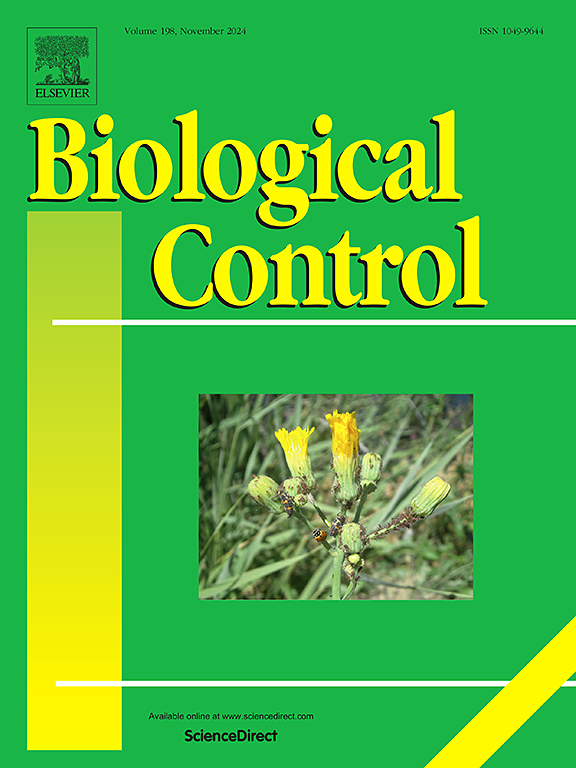Exploring the potential of Metarhizium species for the control of Euschistus heros (Hemiptera: Pentatomidae)
IF 3.4
2区 农林科学
Q2 BIOTECHNOLOGY & APPLIED MICROBIOLOGY
引用次数: 0
Abstract
Entomopathogenic fungi have been widely used for sustainable agriculture as biological pest control agents. However, commercially available isolates were not efficient in controlling the stink bug Euschistus heros (Hemiptera: Pentatomidae), one of the most destructive species in soybean cultivation. There is an increasing demand for exploring new microorganisms that have the potential to control this insect. The present study evaluated the susceptibility of E. heros to 15 isolates of different species of the genus Metarhizium. A mortality rate of over 95 % was observed in isolates of M. pingshaense, M. humberi, and M. robertsii in 8 days of experiment. The aerial conidia yield of ESALQ 4395 and ESALQ 3364 isolates stood out with a concentration above 1x109 conidia/g of dry rice, which is similar to commercial isolates. The average lethal concentration of these isolates was 5.1x105 conidia/mL for adult insects, with a 95 % confidence interval of 4.7x105 to 5.4x105 conidia/mL for ESALQ 4395 and 4.8x105 to 5.5x105 conidia/mL for ESALQ 3364. However, no age-dependent mortality was observed since mortality among adults was more pronounced than in immature insects. Although low efficiency of entomopathogenic fungi for controlling stink bugs has been associated with the fungistatic and fungicidal action of the volatile compounds present in the alarm pheromone, the data obtained here demonstrated that this insect is highly susceptible to Metarhizium, especially to species that are not explored commercially in Brazil such as M. humberi, M. pinghaense and M. robertsii.

绿僵菌种防治大灰狼的潜力探讨(半翅目:蝽科)
昆虫病原真菌作为生物害虫防治剂在可持续农业中得到了广泛的应用。然而,市售的分离物对大豆种植中最具破坏性的臭虫之一——赤羊蝽(Euschistus heros,半翅目:Pentatomidae)的防治效果不佳。人们越来越需要探索有可能控制这种昆虫的新微生物。本研究对15株绿僵菌属分离株进行了敏感性评价。实验8 d后,平山支原体、亨贝里支原体和罗伯特支原体分离株的死亡率均在95%以上。ESALQ 4395和ESALQ 3364的气生分生孢子产量在1 × 109个/g干米以上,与商业分离株相近。对成虫的平均致死浓度为5.1 × 105孢子/mL, ESALQ 4395和ESALQ 3364的平均致死浓度分别为4.7 × 105 ~ 5.4 × 105孢子/mL和4.8 × 105 ~ 5.5 × 105孢子/mL。然而,没有观察到年龄依赖性的死亡率,因为成虫的死亡率比未成熟的昆虫更明显。虽然昆虫病原真菌控制臭虫的低效率与报警信息素中存在的挥发性化合物的抑菌和杀真菌作用有关,但本文获得的数据表明,这种昆虫对绿僵菌非常敏感,特别是对巴西未进行商业开发的物种,如M. humberi, M. pinghaense和M. robertsii。
本文章由计算机程序翻译,如有差异,请以英文原文为准。
求助全文
约1分钟内获得全文
求助全文
来源期刊

Biological Control
生物-昆虫学
CiteScore
7.40
自引率
7.10%
发文量
220
审稿时长
63 days
期刊介绍:
Biological control is an environmentally sound and effective means of reducing or mitigating pests and pest effects through the use of natural enemies. The aim of Biological Control is to promote this science and technology through publication of original research articles and reviews of research and theory. The journal devotes a section to reports on biotechnologies dealing with the elucidation and use of genes or gene products for the enhancement of biological control agents.
The journal encompasses biological control of viral, microbial, nematode, insect, mite, weed, and vertebrate pests in agriculture, aquatic, forest, natural resource, stored product, and urban environments. Biological control of arthropod pests of human and domestic animals is also included. Ecological, molecular, and biotechnological approaches to the understanding of biological control are welcome.
 求助内容:
求助内容: 应助结果提醒方式:
应助结果提醒方式:


